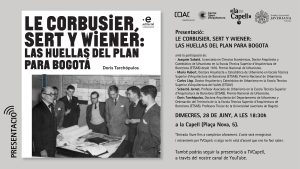Abstract
This essay is the basis for a thesis, according to which an urban transcendent planning tool belonging to the functional ideology of the Modern Movement may be acknowledged as being of prime importance. The theme is the Plan for Bogotá, elaborated in several phases by Le Corbusier and Josep Lluís Sert & Paul Lester Wiener between 1949 and 1963, This is a work which has been very sparsely mentioned in international historiography of architecture and/or urban planning, and has generated little or no critical interest or deep analysis as part of the Latin American regional case1, or particularly, that of Bogotá. This Plan, besides its projectual and instrumental novelties (for its time), is remarkable for its historical, methodological and practical dimensions and for its dialectic between the values and principles that guided it and its final product, the city itself. Through the study of the urban event, of the processes and the product created by this experience, the codes which reverberated through the Bogotá town planning will be eventually identified, then put to work to rescue questions and answers that may contribute ideas and solutions to contemporary town planning. Several significant events point out the historical importance of the Plan. It was not only the second and last time for le Corbusier and Sert ¿ two noted CIAM protagonists ¿ to work together in town planning, 16 years after participating in the Maciá Plan for Barcelona, but also the only Plan for a Latin American city completely worked out by Le Corbusier, having signed a formal contract for that purpose. Like Sert and other renowned architects, Le Corbusier strove to leave his own imprint in Latin America2. In the Colombian scope the Plan may be considered a significant event, being the work of two emblematic figures of the Modern Movement and also for its importance for Colombian society, involving it as a whole in a project that became part of its own future development by the creation of a pioneering instrument for an integral city project, and also for its instrumental content and the legal expression of a compendium of regulations in accordance with the principles and methodology of Modern Urbanism. However, this, like many other ideas and proposals towards modernization of cities, did not transcend their time nor were they registered in Colombian history as a notably significant chapter (del Castillo, 2003). In its methodological dimension, the Bogotá Plan incorporates several instrumental measures, not used previously in Modern Town Planning, either in its international or its local versions, among which the following may be noted : the proposal of a theoretical city model, summarizing the main elements of urban politics at city, metropolitan and regional levels. The city Civic Center ¿ and its replicas at quarter or ¿barrio¿ level – represents an entirely new urban function. Urban sectors and their street network, arranged in a hierarchy according to the 7v¿s Rule, as the indispensable basic structure for circulation and urban design at an intermediate scale and as a deductive result of Corbusian thought about the shape of cities at that date (Le Corbusier 1951: Jeanneret et al. 1951), 1959 (Bannen Lanata 1991; Cortés 1995; Salmona 2003). The graphic image of the Plan and its version for the CIAM grille, which consisted of a series of plans systematically arranged to show both the form and analysis of the proposals for the city, to be shown in comparison with other plans at the CIAM 8 meeting on The Heart of the City.
Access the thesis











